Best Mics For Recording Electric Guitar (2024 Update)
When it comes to recording electric guitar, choosing the right microphone is crucial for capturing your tone and getting professional sounding results. With so many options on the market, it can be overwhelming trying to determine which mic is best suited for your needs and budget. Here are a few key factors to consider as you shop for the ideal electric guitar recording microphone.
First, look at the type of microphone and its polar pattern or pick-up area. Large diaphragm condenser mics generally provide the most detailed and full-bodied reproduction, while small diaphragm condensers excel at crisp highs and tight lows. Dynamic mics handle loud volumes well and give a balanced sound. Ribbon mics are known for their smooth, natural tone. The polar pattern determines how much sound the mic picks up from different directions.
You’ll also want to consider if the microphone is designed specifically for guitar amp recording, as these will be optimized for that purpose. Frequency response is another spec to examine, you want a mic that captures the full range from punchy lows to articulate highs.
Durability is also a factor since guitars and amps can produce very high sound pressure levels. Make sure the mic you choose can handle those volumes without distorting or breaking.
Additional aspects that affect your decision are your budget, features like pads and filters, and form factor. Do you need a stand mount or handheld mic?
With research and trial and error, you’ll find the ideal electric guitar recording microphone for your needs and style. The right mic helps capture your true live tones, so you get professional recordings with clarity and depth. Let your inner guitarist shine through with a microphone suited for electric guitar.
10 Best Mics For Recording Electric Guitar
| # | Product Image | Product Name | Product Notes | Check Price |
|---|---|---|---|---|
|
1
|
The product is ideal for amplifying classical guitar music during live performances or recording sessions.
|
|
||
|
2
|
Ideal for recording high-quality audio in a variety of settings, including live performances and studio sessions.
|
|
||
|
3
|
Ideal for musicians playing electric instruments who want a high-quality wireless transmission system with easy setup and charging.
|
|
||
|
4
|
This product is ideal for musicians playing electric instruments who want to go wireless in their performances.
|
|
||
|
5
|
This product is ideal for capturing high quality sound from both vocals and instruments with a durable design.
|
|
||
|
6
|
The product is ideal for recording vocals and instruments with a clear and natural sound.
|
|
||
|
7
|
The product is ideal for recording vocals, acoustic instruments, and studio applications due to its condenser microphone design.
|
|
||
|
8
|
Ideal for musicians looking for a wireless microphone system to amplify and enhance the sound of their classical or acoustic guitar performances.
|
|
||
|
9
|
The product is ideal for recording high-quality audio in a variety of settings, such as music production and podcasting.
|
|
||
|
10
|
The product is ideal for capturing clear and accurate audio in a cardioid pattern for various recording applications.
|
|
1. The Feather Classical Guitar Microphone With Flexible Micro-Gooseneck By Myers Pickups
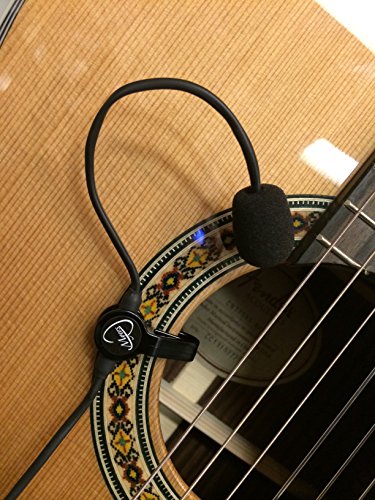
Introducing the new Feather pickup by Myers Pickups, a lightweight and compact powerhouse that amplifies the natural tone and beauty of your instrument. Unlike other pickups, the Feather requires no modification or permanent installation, making it a versatile option for a multitude of instruments.
Equipped with an internally powered active preamp, this pickup produces the richest sound your instrument can deliver. The power source, which is included, is pre-installed, and each pickup is meticulously tested before delivery to ensure top-notch quality.
Installation is a breeze with all mounting hardware included, allowing you to instantly turn your instrument into an acoustic/electric one with volume. The Feather is compatible with almost any musical instrument, making it a versatile choice for musicians of all kinds.
Best of all, the Feather is made in the USA, ensuring top-quality craftsmanship and durability. Please note that the instrument is not included, but everything else you need to get started is. Overall, the Myers Pickups Feather is an exceptional option for musicians looking to amplify their sound without sacrificing the natural tone and beauty of their instrument.
2. Se Electronics – V Pack Club Feat. V Kick 2 V Beat W/clamps V7 X Pair Of Se7 With Case
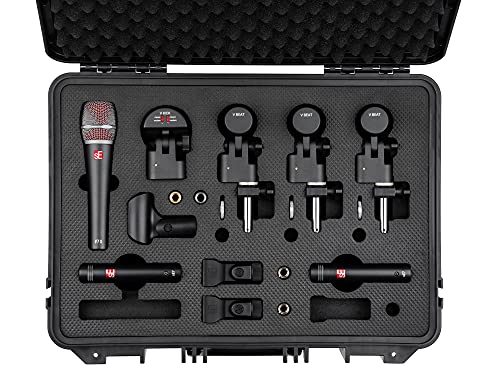
The V Kick is a high-quality drum microphone set that is designed to capture the rich, detailed sound of a kick drum. This set includes a pair of V Beats with clamps, as well as a V7 X Snare Mic and a pair of sE7 Overhead Condenser Mics. The set also comes with a sturdy case for convenient storage and transport.
The V Beats are highly durable and versatile microphones that are designed to handle the demands of live performances and studio recording. They feature a compact design and a high-output dynamic capsule that delivers a warm, punchy sound with excellent clarity and definition. The included clamps make it easy to position the microphones exactly where you need them.
The V7 X Snare Mic is a premium dynamic microphone that is specifically designed for snare drum applications. It features a specialized capsule that is tuned to capture the natural resonance and tonality of the snare drum, while rejecting unwanted noise and feedback. The microphone also features a supercardioid polar pattern, which helps to isolate the sound source and minimize off-axis noise.
The sE7 Overhead Condenser Mics are high-quality microphones that are designed for capturing the natural sound of cymbals, hi-hats, and other overhead percussion instruments. They feature a small-diaphragm condenser capsule that delivers a detailed, transparent sound with excellent transient response and high-frequency clarity. The mics also feature a cardioid polar pattern, which helps to reject off-axis sound and minimize feedback.
3. Wireless Guitar System – Play Without Limits!
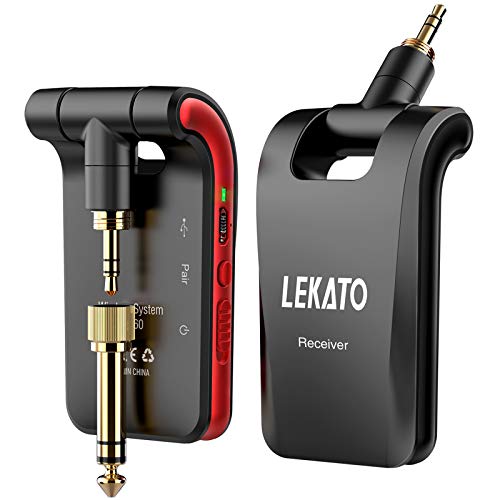
This wireless guitar system is the perfect solution for musicians who want to enjoy a hassle-free and high-quality sound experience. With its stereo sound capabilities, it supports various musical instruments such as electronic drums, passive pickup guitars, and bass, giving music a sense of hierarchy and space.
This transmitter and receiver set includes both 1/8" and 1/4" plugs, catering to both mono and stereo musical instruments, making it versatile and convenient. The 1/4" mono plugs are compatible with most acoustic-electric guitars, while the 6.35mm and 3.5mm stereo plugs can be used with audio products such as cameras, phones, and tablets to edit music. It is important to note that the receiver with a 1/8" plug does not have a headphone amp function and is therefore not suitable for headphones.
The wireless guitar system boasts clear signal transmission with its 2.4GHz frequency, 24bit/48KHz stereo lossless digital transmission sampling rate, and less than 12ms latency. It has an effective range of over 100 feet and provides low latency, no signal loss, and low noise, ensuring professional sound quality.
The built-in rechargeable lithium battery is long-lasting, supporting up to 4-5 hours of playing time and quick charging within 2 hours. It also comes with a double-ended USB cable to ensure optimal performance for every show.
The transmitter and receiver can support up to 6 sets of devices working simultaneously, without any interference. The one-to-one transmission feature allows one transmitter to transmit signals to several receivers at the same time, making it a great choice for band performances or other group settings.
4. Joyo Wireless Guitar System – Unleash Your Sound!
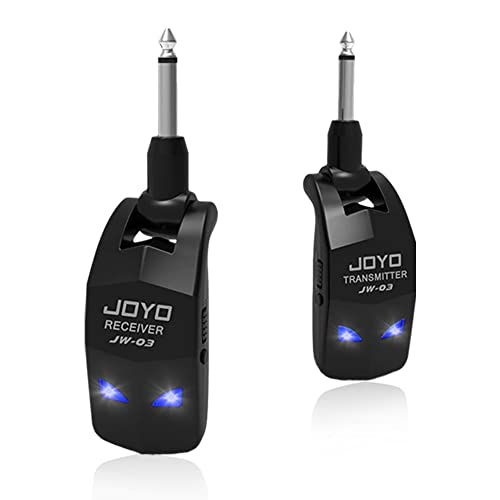
Experience clear and uninterrupted sound with this high-performing guitar wireless system. The 2.4GHz band technology ensures optimal signal transmission with low noise and latency, which is less than 5mS, and no interference. You can enjoy over 20 meters of transmission distance without any signal loss.
This wireless system is compatible with most electric guitars, bass, acoustic guitars, and other digital music instruments. The plugs can be rotated for 220 degrees, making it easy to use with a variety of instruments. Additionally, this device is approved for worldwide use, so you can take it with you wherever you go.
Pairing the transmitter and receiver is quick and easy. Simply turn on both devices, press the pairing button on the receiver, then press and hold the pairing button on the transmitter for more than 2 seconds. Once paired successfully, you can enjoy the freedom of wireless playing.
The double-sided USB cable makes charging the transmitter and receiver a breeze. You can charge both devices simultaneously with ease. Additionally, switching between the 4 signal channels is a breeze, making it easy to find the best signal for your instrument.
The built-in battery provides over 8 hours of battery life once fully charged, enough to enjoy the wireless world in your gig. This guitar wireless system is user-friendly, making it easy to use, even for beginners. Enjoy the ultimate playing experience with this high-quality wireless system.
5. Shure Beta 57a: Dynamic, Durable Instrument Mic.
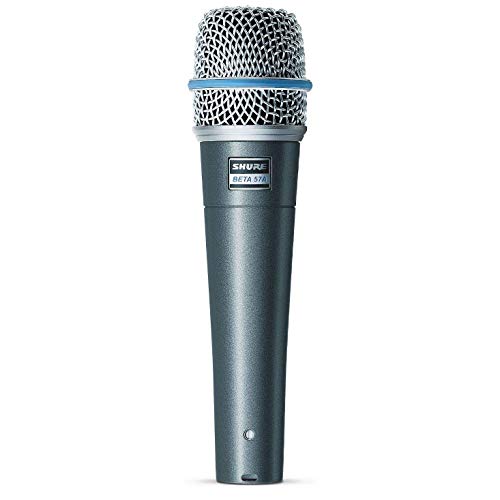
The dynamic instrument microphone is the perfect choice for musicians and sound engineers looking for superior sound quality. With its tailored frequency response, it provides drums, guitars, vocals, and horns with studio-quality sound that is sure to impress. The uniform supercardioid pattern ensures high gain-before-feedback and superior rejection of off-axis sound for clear and crisp audio.
Constructed with a hardened steel mesh grille, this microphone is designed to resist wear and abuse, while also facilitating the use of proximity effect. The neodymium magnet ensures a high signal-to-noise ratio output, making it minimally affected by varying load impedance.
The advanced pneumatic shock mount system minimizes the transmission of mechanical noise and vibration, ensuring that the microphone captures only the desired sound. With legendary Shure quality and reliability, this microphone is built to last and perform at its best in even the most demanding environments.
Included in the box are the A25D Stand Adapter, 95A2050 5/8” to 3/8” (Euro) Thread Adapter, and 26A21 Storage Bag, making it easy to store and transport the microphone. Overall, this dynamic instrument microphone is a top-of-the-line choice for any musician or sound engineer looking for exceptional sound quality and reliable performance.
6. Universal Audio Sd-1 Standard Dynamic Microphone
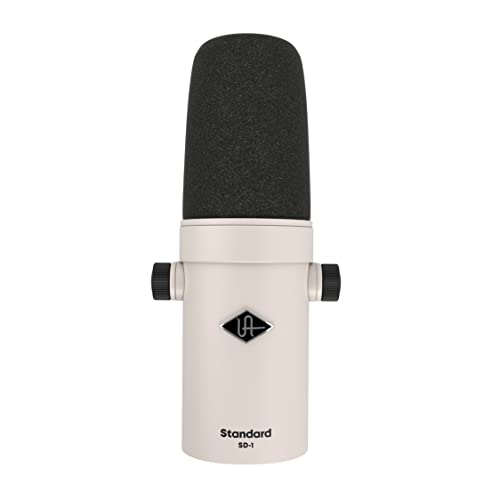
The SD-1 dynamic cardioid microphone is an ideal choice for capturing close-miked vocals and instruments. Its classic design ensures a natural, uncolored sound that faithfully represents the source. With a flat, wide-range frequency response, the SD-1 is capable of capturing a broad range of frequencies with accuracy and detail.
To enhance the clarity and presence of your recordings, the SD-1 comes equipped with low-cut and enhanced articulation boost switches. These features allow you to tailor the sound to your preferences and ensure that your recordings stand out from the crowd.
The SD-1 also includes a set of Apollo Channel Strip Presets, which offer a range of shaping options for vocals and instruments. These presets make it easy to achieve a professional-sounding mix, even if you're not an experienced audio engineer.
Whether you're recording vocals, guitar, drums, or any other instrument, the SD-1 dynamic cardioid microphone is a versatile and reliable choice. Its rugged construction and high-quality components ensure that it will provide years of reliable service, while its neutral and natural sound make it a favorite among musicians and engineers alike.
7. Mxl V67g Fet Designed Condenser Microphone

The product boasts a large 32mm pressure gradient condenser capsule that delivers exceptional audio quality. Its gold-sputtered, 6 micron density diaphragm ensures accurate sound reproduction, making it perfect for recording vocals, instruments, and more.
The solid state preamp provides a balanced transformer output, reducing interference and ensuring a clear and clean signal.
For added convenience and improved recording quality, the MXL-57 isolation shock mount is available. This shock mount effectively isolates the microphone from vibrations and other unwanted noise, providing a more professional recording experience.
8. Mamkoes Wireless Guitar Mic System.
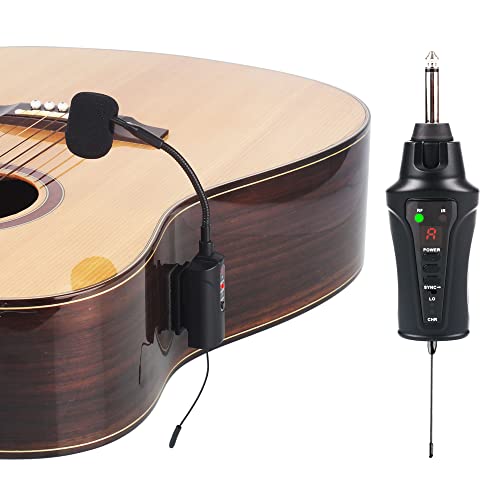
Introducing the ultimate solution for guitarists who want to play freely without being tethered by cords! This wireless guitar microphone system boasts numerous features that make it an excellent choice for musicians.
The first thing to note is the non-mark adhesive that allows you to tear off the system without damaging your instrument's paint. This feature ensures that you can use the system without worrying about damaging your guitar.
The system is equipped with a condenser microphone core that enables it to produce high-quality sound. With a sound reproduction rate of 99%, you can be sure that your audience will hear every note, making your performance more engaging and enjoyable.
The system also boasts a stable signal transmission, with a range of 164ft (50m). It provides 16 UHF channels to choose from, and you can use up to three or four microphone systems at the same time without experiencing signal interference. This feature makes it ideal for use in group performances.
The system is easy to use, and you can attach the Dual Lock on the side of your guitar or near the sound hole. You can choose a location that won't hinder your playing. After attaching the Dual Lock, stick the transmitter's Dual Lock to it. Plug the receiver into the MIC interface of your speaker and turn it on. You can then start using it.
The wireless guitar microphone system also comes with a high-capacity lithium battery. The package includes a cable that can charge the receiver and transmitter simultaneously, which significantly reduces charging time. The transmitter and receiver have a 750mAh battery that can be recharged up to 2000 times. After charging for two hours, they can be used for up to six hours.
This guitar wireless microphone system is versatile and can be used in solo performances, accompaniment performances, personal entertainment, and group performances. It features a 1/4 inch plug and comes with a 1/4 inch (6.35mm) to 1/8 inch (3.5mm) conversion plug, making it compatible with various equipment such as loudspeakers, computer audio, drawbar speakers, mixers, and more.
9. Se Electronics – X1 Series Large Condenser Microphone And Clip
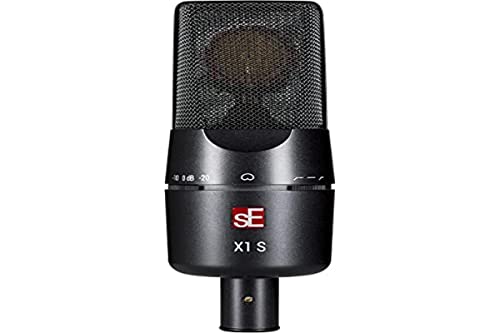
Looking for a reliable and high-quality microphone? Look no further than this top-of-the-line product, which boasts an impressive frequency range of 20hz to 20khz. This means that you'll be able to capture every nuance of your recordings, whether you're singing, speaking, or playing an instrument.
In addition to its impressive frequency range, this microphone also boasts a powerful 48v power supply. This ensures that your recordings are clear and crisp, with no background noise or interference to detract from their quality.
Another key feature of this microphone is its impressive sensitivity of 30mV/Pa. This means that it will pick up even the slightest sounds and nuances, allowing you to create professional-quality recordings that are sure to impress your listeners.
In terms of power consumption, this microphone is also highly efficient, with a current consumption of just 6mA. This means that it won't drain your batteries or put undue strain on your recording equipment, making it an ideal choice for both professional and amateur recording artists alike.
Finally, this microphone boasts an impedance of 125 ohms, which ensures that it will work seamlessly with a wide range of recording equipment and setups. So whether you're recording in a professional studio or a home setup, you can rest assured that this microphone will deliver the high-quality results you need.
10. Se Electronics – Se8 Small Diaphragm Cardioid Condenser Mic With Gold Sputtered Diaphragm

This high-quality product boasts impressive specifications that are sure to impress any audio enthusiast. With a frequency range of 20hz-20khz, it is capable of capturing a wide range of sounds with exceptional clarity and detail. Additionally, it features 48v power, ensuring that it can handle even the most demanding recording situations.
The product's sensitivity of 25mV/Pa is another notable feature, allowing it to pick up even the subtlest nuances in a recording. And with a maximum SPL of 139/149/159 db, it is more than capable of handling high-volume sources without distortion or clipping.
Finally, the product's impedance of 110 ohms ensures that it is compatible with a wide range of audio equipment, making it a versatile and reliable choice for any recording setup. Overall, this product is an excellent choice for anyone seeking professional-grade audio performance.
Best Mics For Recording Electric Guitar FAQs
Are there any specific microphone brands or models that are known for working well with electric guitar?
When it comes to choosing a microphone for electric guitar, there are several factors to consider, such as the type of sound you're looking for, the pickup pattern, and the microphone's frequency response. While there are no specific microphone brands or models that are exclusively designed for electric guitars, some microphones are known to work exceptionally well with them.
One popular option is the Shure SM57, which is a dynamic microphone that has been a staple in the music industry for many years. It has a cardioid pickup pattern, which helps to isolate the sound source and reduce background noise. The SM57 is also known for its bright and crisp sound, making it ideal for capturing the high-end frequencies of an electric guitar.
Another great option is the Sennheiser e609, which is a dynamic microphone that is specifically designed for guitar amps. It has a super-cardioid pickup pattern, which means it can capture sound from a more focused area than a regular cardioid mic. The e609 is also designed to be placed directly in front of the amp, making it perfect for live performances.
Overall, when choosing a microphone for electric guitar, it's important to consider your specific needs and preferences. Experimenting with different brands and models can help you find the perfect microphone that suits your style and sound.
Can I use a microphone to capture the sound of an electric guitar amp, or should I use a direct recording method?
Both methods have their advantages and disadvantages, so it ultimately depends on your personal preference and the sound you're going for.
Using a microphone to capture the sound of an electric guitar amp can provide a more natural and organic sound, as the microphone will pick up the nuances of the sound coming from the speaker. This can result in a warmer and more dynamic tone. However, using a microphone also means that you have to deal with issues such as mic placement, room acoustics, and potential bleed from other instruments.
On the other hand, using a direct recording method involves connecting the guitar directly to an audio interface or recording device, bypassing the amp altogether. This can provide a cleaner and more consistent sound, with less potential for external interference. However, some guitarists feel that this method can result in a more sterile or artificial sound, lacking the character and warmth of a mic'd amp.
Ultimately, there is no right or wrong answer – it's up to you to experiment and find the method that works best for your particular setup, playing style, and musical preferences.
Can I use multiple microphones to record electric guitar, and if so, what is the best setup?
Yes, you can use multiple microphones to record electric guitar. In fact, using multiple microphones can help capture different aspects of the guitar's sound and provide more options in the mixing process.
The most common setup for recording electric guitar with multiple microphones is the "close-mic" and "room-mic" technique. This involves placing one microphone close to the amplifier's speaker cabinet (usually a dynamic or condenser mic) to capture the direct sound of the guitar, and a second microphone farther away (usually a condenser mic) to capture the ambience of the room.
Another setup is the "stereo-mic" technique where two matched microphones are placed on either side of the amplifier's speaker cabinet to capture a stereo image of the guitar's sound.
It's important to experiment with microphone placement and test different combinations to find the best sound for your specific recording. Additionally, using a good preamp and high-quality cables can also make a big difference in the overall sound quality.
Do I need a preamp or DI box to use a microphone for electric guitar recording?
When it comes to recording electric guitars, using a microphone is a popular choice to capture the instrument's natural sound. However, you may wonder if you need a preamp or DI box to use a microphone for electric guitar recording.
The short answer is that it depends on your setup and the type of microphone you are using. If you are using a dynamic microphone such as a Shure SM57, you can plug it directly into your audio interface or mixer and get a decent sound without the need for a preamp or DI box. However, if you are using a condenser microphone, you will need to use a preamp or a mixer with built-in preamps to power the microphone and boost its signal to a usable level.
A DI box is not necessary for electric guitar recording with a microphone, as it is typically used to convert a high-impedance, unbalanced instrument signal into a low-impedance, balanced signal for use with a mixer or audio interface. However, if you are using an active DI box with a microphone, it can provide additional gain and tone shaping options that can enhance your recordings.
In conclusion, whether you need a preamp or DI box for electric guitar recording with a microphone depends on your specific setup and the type of microphone you are using, but it is possible to get a great sound without them.
How do different microphone types (dynamic, condenser, ribbon) affect the sound of an electric guitar recording?
Different microphone types have a significant impact on the sound of an electric guitar recording. Dynamic microphones are the most commonly used for live performances due to their durability and ability to handle high sound pressure levels. They have a warmer and more punchy sound, making them ideal for capturing the grit and aggression of distorted guitar tones.
Condenser microphones, on the other hand, are more sensitive and delicate. They have a wider frequency response and capture more detail, making them perfect for clean and acoustic guitar recordings. They are also commonly used in studio settings due to their ability to capture subtle nuances and harmonics that other microphones may miss.
Ribbon microphones have a vintage sound and are often used for more natural and warm recordings. They have a smooth and natural sound that complements the natural tone of the electric guitar. They are also known for their ability to capture the room ambience, making them ideal for recording in a live room or a large studio.
In conclusion, the type of microphone used for electric guitar recordings has a massive impact on the final sound. Each microphone type has its strengths, and it's up to the producer or engineer to choose the right one based on the desired sound and style of the recording.
How does the quality of the microphone impact the final sound of an electric guitar recording?
The quality of the microphone can have a significant impact on the final sound of an electric guitar recording. A high-quality microphone can capture the nuances of the guitar's tone, resulting in a more accurate and professional-sounding recording. On the other hand, a low-quality microphone can produce a distorted or muddy sound that lacks clarity and definition.
When recording an electric guitar, it's essential to choose the right type of microphone that suits the sound you're trying to achieve. Dynamic microphones are often used for recording guitar amps as they can handle high sound pressure levels and produce a warm, punchy sound. Condenser microphones, on the other hand, are more sensitive and can capture more detail in the guitar's tone, making them ideal for recording acoustic guitars or clean electric guitar tones.
In conclusion, the quality of the microphone plays a crucial role in the final sound of an electric guitar recording. Investing in a high-quality microphone can result in a more professional and polished recording, while a low-quality microphone can hinder the quality of the recording.
What are some affordable options for mics that work well for recording electric guitar?
There are various affordable options for mics that work well for recording electric guitar. Dynamic microphones are a popular choice due to their durability and ability to handle high sound pressure levels. The Shure SM57 is a classic dynamic mic that is widely used for recording electric guitar amps, and it is also budget-friendly. Another option is the Sennheiser e609, which has a unique design that allows it to be positioned close to the amp for a more focused sound.
Condenser microphones are also a good option, especially for capturing the nuances of an acoustic guitar. The Audio-Technica AT2020 is a popular condenser mic that is suitable for recording electric guitars as well, and it is reasonably priced. Another option is the Rode NT1-A, which is known for its clarity and low noise.
Ultimately, the best mic for recording electric guitar depends on personal preference and the specific sound you are trying to achieve. However, these affordable options are a great place to start for those on a budget.
What are the best microphone placement techniques for recording electric guitar?
When it comes to recording electric guitar, microphone placement is critical in achieving the desired sound. There are a few techniques that are commonly used by recording engineers to capture the best sound of an electric guitar.
One of the most popular techniques is the close-mic method, where a dynamic microphone is placed directly in front of the speaker. This method is great for capturing the guitar's natural sound and can be adjusted to capture different tones by moving the mic closer or further away from the speaker.
Another technique is to use two microphones, one close and one farther away from the speaker. This allows for the capture of both the direct sound and the room sound, which can add depth and dimension to the recording.
A third technique is the use of a room microphone, which is placed further back in the room to capture the natural reverb of the space. This technique can add a sense of space to the recording and is particularly useful for rock and blues guitar recordings.
Ultimately, the best microphone placement techniques for recording electric guitar will depend on the desired sound and the unique characteristics of the guitar and amplifier being used. Experimentation and experience are key to finding the perfect placement for each recording session.
What are the best mics for recording electric guitar?
When it comes to recording electric guitar, there are several types of microphones to choose from, each with its own unique characteristics. The most commonly used mics for recording electric guitar are dynamic, condenser, and ribbon microphones.
Dynamic microphones, such as the Shure SM57, are excellent for recording distorted guitar tones. They are capable of handling high sound pressure levels (SPL) and are highly directional, meaning they can isolate the sound of the guitar amp from other ambient noise in the room.
Condenser microphones, such as the Audio-Technica AT4053b, are more sensitive than dynamic mics and are great for capturing the subtle nuances of clean and acoustic guitar tones. They have a wider frequency response and can capture a more detailed sound.
Ribbon microphones, such as the Royer R-121, are often used to capture the warmth and natural tone of a guitar amp. They have a unique bi-directional polar pattern that captures sound from both the front and back of the mic, resulting in a more natural and open sound.
Ultimately, the best mic for recording electric guitar will depend on the specific tone you are trying to capture and the sound of your guitar amp. It's always a good idea to experiment with different mics to find the one that works best for your particular situation.
What factors should I consider when choosing a microphone for electric guitar recording?
When choosing a microphone for electric guitar recording, there are several factors to consider. Firstly, the type of microphone you choose will have a significant impact on the tone you capture. Dynamic microphones are great for capturing a punchy and aggressive tone, while condenser microphones are better suited for capturing a more detailed and airy sound.
Secondly, placement of the microphone is crucial. Experiment with different distances and angles to find the sweet spot that captures the desired tone. Typically, placing the microphone close to the guitar speaker cone will capture a brighter and more focused sound, while moving it further back will result in a more ambient and roomy tone.
Thirdly, consider the polar pattern of the microphone. A cardioid pattern will capture sound from the front and reject sound from the sides and back, while an omnidirectional pattern will capture sound from all directions. A figure-eight pattern will capture sound from the front and back while rejecting sound from the sides.
Lastly, budget is an important factor to consider. High-end microphones can be expensive, but there are also affordable options that can produce great results. Ultimately, the best microphone for electric guitar recording will be the one that suits your budget and captures the tone you desire.







